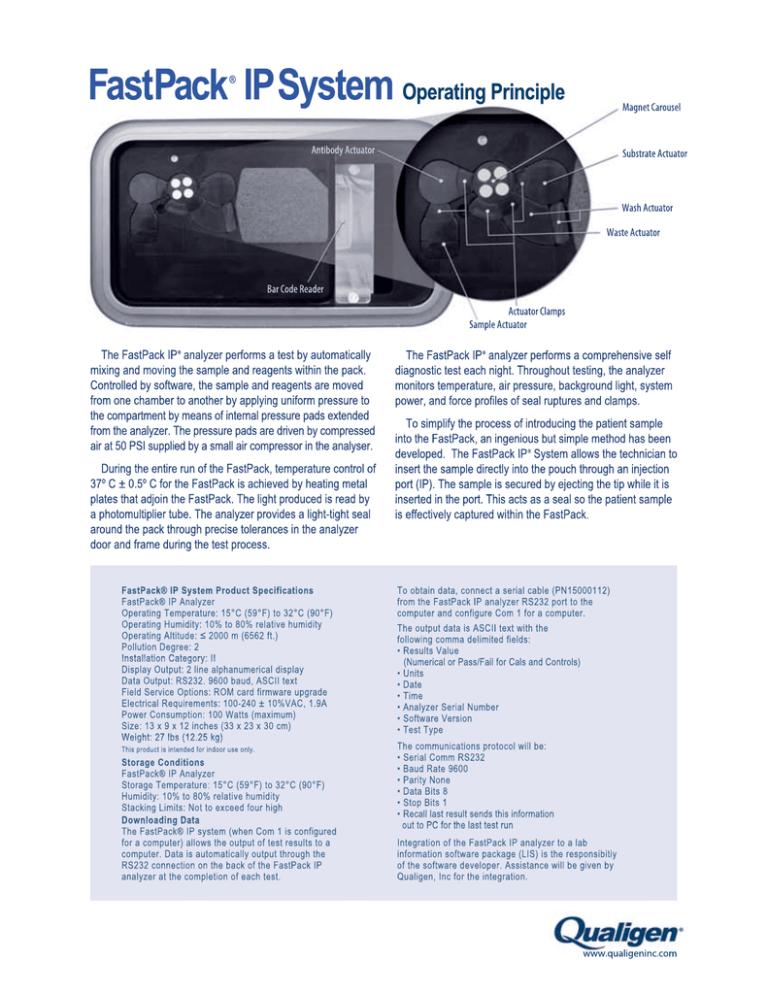
FastPack IP System Operating Principle
®
.BHOFU$BSPVTFM
"OUJCPEZ"DUVBUPS
4VCTUSBUF"DUVBUPS
8BTI"DUVBUPS
8BTUF"DUVBUPS
#BS$PEF3FBEFS
"DUVBUPS$MBNQT
4BNQMF"DUVBUPS
The FastPack IP analyzer performs a test by automatically
mixing and moving the sample and reagents within the pack.
Controlled by software, the sample and reagents are moved
from one chamber to another by applying uniform pressure to
the compartment by means of internal pressure pads extended
from the analyzer. The pressure pads are driven by compressed
air at 50 PSI supplied by a small air compressor in the analyser.
®
During the entire run of the FastPack, temperature control of
37º C ± 0.5º C for the FastPack is achieved by heating metal
plates that adjoin the FastPack. The light produced is read by
a photomultiplier tube. The analyzer provides a light-tight seal
around the pack through precise tolerances in the analyzer
door and frame during the test process.
FastPack® IP System Product Specifications
FastPack® IP Analyzer
Operating Temperature: 15°C (59°F) to 32°C (90°F)
Operating Humidity: 10% to 80% relative humidity
Operating Altitude: ≤ 2000 m (6562 ft.)
Pollution Degree: 2
Installation Category: II
Display Output: 2 line alphanumerical display
Data Output: RS232. 9600 baud, ASCII text
Field Service Options: ROM card firmware upgrade
Electrical Requirements: 100-240 ± 10%VAC, 1.9A
Power Consumption: 100 Watts (maximum)
Size: 13 x 9 x 12 inches (33 x 23 x 30 cm)
Weight: 27 lbs (12.25 kg)
This product is intended for indoor use only.
Storage Conditions
FastPack® IP Analyzer
Storage Temperature: 15°C (59°F) to 32°C (90°F)
Humidity: 10% to 80% relative humidity
Stacking Limits: Not to exceed four high
Downloading Data
The FastPack® IP system (when Com 1 is configured
for a computer) allows the output of test results to a
computer. Data is automatically output through the
RS232 connection on the back of the FastPack IP
analyzer at the completion of each test.
The FastPack IP analyzer performs a comprehensive self
diagnostic test each night. Throughout testing, the analyzer
monitors temperature, air pressure, background light, system
power, and force profiles of seal ruptures and clamps.
®
To simplify the process of introducing the patient sample
into the FastPack, an ingenious but simple method has been
developed. The FastPack IP System allows the technician to
insert the sample directly into the pouch through an injection
port (IP). The sample is secured by ejecting the tip while it is
inserted in the port. This acts as a seal so the patient sample
is effectively captured within the FastPack.
®
To obtain data, connect a serial cable (PN15000112)
from the FastPack IP analyzer RS232 port to the
computer and configure Com 1 for a computer.
The output data is ASCII text with the
following comma delimited fields:
• Results Value
(Numerical or Pass/Fail for Cals and Controls)
• Units
• Date
• Time
• Analyzer Serial Number
• Software Version
• Test Type
The communications protocol will be:
• Serial Comm RS232
• Baud Rate 9600
• Parity None
• Data Bits 8
• Stop Bits 1
• Recall last result sends this information
out to PC for the last test run
Integration of the FastPack IP analyzer to a lab
information software package (LIS) is the responsibitiy
of the software developer. Assistance will be given by
Qualigen, Inc for the integration.
XXXRVBMJHFOJODDPN
FastPack IP System Assay Principle
®
*OKFDUJPOQPSU
8BTUF$IBNCFS
4BNQMF$IBNCFS
"OUJCPEZ4PMVUJPO$IBNCFS
8BTI4PMVUJPO$IBNCFS
4VCTUSBUF$IBNCFS
Chamber #
3FBDUJPO$IBNCFS
Description
Contents
Explanation
1
Sample Chamber
Serum or Plasma
Patient sample is inserted through a very simple,
positive displacement pipette process.
2
Conjugate Chamber
Capture and Labeled Antibodies
Attach and capture the target molecule from
the patient sample that is being identified.
3
Reaction Chamber
Paramagnetic Particles
Housed in this space are the coated paramagnetic particles
which represent the solid phase of an immunoassay reaction.
4
Substrate Chamber
Light Sensitive Substrate
When everything is properly in place, photons are emitted by
the substrate which equates to a target molecule concentration.
5
Wash Solution Chamber
Wash Solution
It is used to wash away excess, unbound materials
in the reaction chamber.
6
Waste Chamber
Empty
All spent wash solution is deposited in this waste chamber.
Both “competitive” and “sandwich” type chemiluminescence
assays may be run on the FastPack IP System. Sandwich
assays are used with large target molecules such as PSA,
TSH and hCG while “Competitive” assays used with very
small target molecules. The next paragraph explains, in
detail, how a “Sandwich” assay runs in the FastPack.
®
In a sandwich assay, a sample with an unknown concentration of the analyte is mixed with excess amounts of capture
antibody and labeled antibody. The mixture is incubated for a
specified time to allow both antibodies to bind to the analyte
in a sandwich format (in Chamber 2).
The mixture is then brought into contact with coated
paramagnetic particles, which bind to the capture antibody
(and thus the analyte).
The analyzer uses a small magnet to hold the paramagnetic particles with their attached sandwiched analyte while
they are washed repeatedly (from chamber 4). The wash
removes any unbound antibody (all done in Chamber 3).
Finally, a substrate solution (from Chamber 6) is added,
which reacts with the labeled antibody and emits light, which
is directly proportional to the concentration of the analyte in
the sample (all in Chamber 3).
How The FastPack IP System Works
®
XXXRVBMJHFOJODDPN
2042 Corte del Nogal, Suite B
Carlsbad, CA 92011
Tel 877.709. 2169
Fax 760.918.9127
Copyright © 2010 Qualigen, Inc. All rights reserved.





